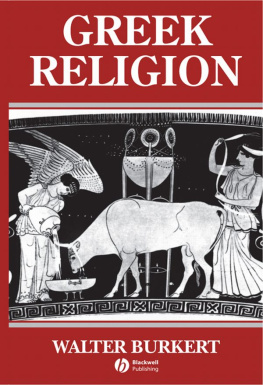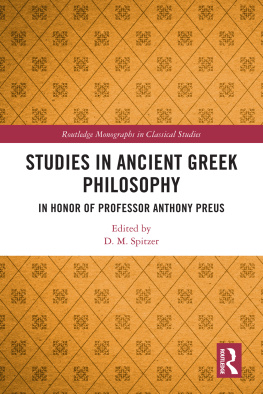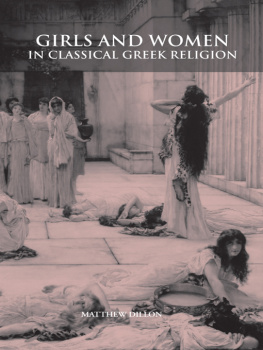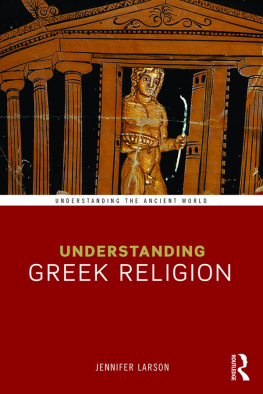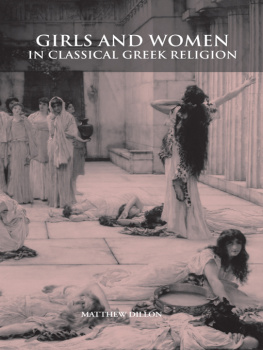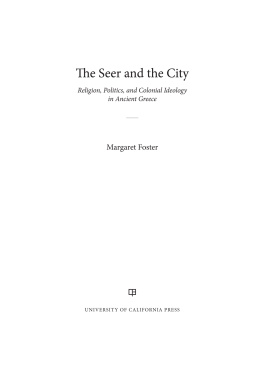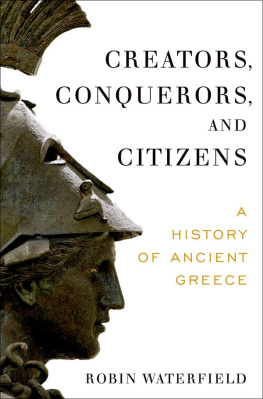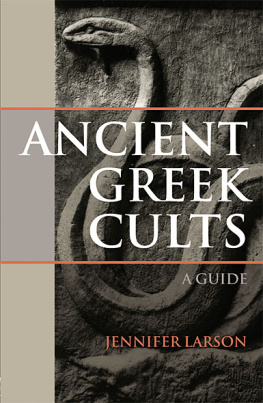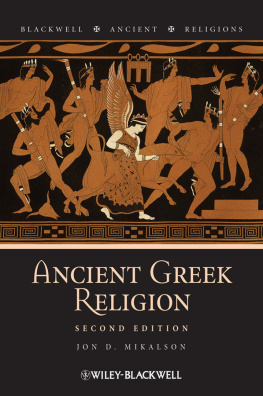
UXORI
English translation 1985 by Blackwell Publishing Ltd and Harvard University Press
Originally published in German as Gricchifichc Religion der archaischcn und klassischett Epoche, in the series Die Religionen der Menschheit, vol. 15.
1977 by Verlag W. Kohlhammer, Stuttgart
BLACKWELL PUBLISHING
350 Main Street, Maiden, MA 02148-5020, USA
9600 Garsington Road, Oxford OX4 2DQ, UK
550 Swanston Street, Carlton, Victoria 3053, Australia
All rights reserved. No part of this publication may be reproduced, stored in a retrieval system, or transmitted, in any form or by any means, electronic, mechanical, photocopying, recording or otherwise, except as permitted by the UK Copyright, Designs, and Patents Act 1988, without the prior permission of the publisher.
English translation first published 1985
First published in paperback 1987
12 2012
British Library Cataloguing in Publication Data
Burkert, Walter
Greek religion: archaic and classical
1. GreeceReligion
I. Title II. Griechische Religion der archaischen
und klassischen Epoche. English
292.08 BL782
ISBN 978-0-631-15624-6
The publishers policy is to use permanent paper from mills that operate a sustainable forestry policy, and which has been manufactured from pulp processed using acid-free and elementary chlorine-free practices. Furthermore, the publisher ensures that the text paper and cover board used have met acceptable environmental accreditation standards.
For further information on
Blackwell Publishing, visit our website:
www.blackwellpublishing.com
Preface to the English Edition
The German edition of this book was published in 1977; the transformation into an English book of 1985 can hardly be complete. The author has used the chance to add references to important new publications that came to his knowledge in the intervening years, especially to newly discovered evidence and to new standard works. Most progress and change is going on in the field of Minoan and Mycenaean religion, so that the short account contained in the first chapter of this book must be taken as a source of clues rather than final results.
W.B.
Introduction
1 A SURVEY OF SCHOLARSHIP
Greek religion has to some extent always remained familiar, but is far from easy to know and understand. Seemingly natural and yet atavistically estranged, refined and barbaric at the same time, it has been taken as a guide again and again in the search for the origin of all religion. But as a historical phenomenon it is unique and unrepeatable, and is itself the product of an involved prehistory.
In Western tradition an awareness of Greek religion was kept alive in three ways: is the last largescale and thoroughly unavailing endeavour of this kind. There was, however, another path which could be taken, namely, to construct a self-consciously pagan counter-position to Christianity. The fascination which this idea exercised can be traced from the time of the Renaissance to Schillers poem Die Gotter Griechenlands (1788) and Goethes Braut von Korinth (1797) and is evident again in the work of Friedrich Nietzsche and Walter F. Otto.
The historical criticism of the nineteenth century abandoned such efforts to fill ancient religion with direct meaning and relevance and devoted itself instead to the critical collection and chronological ordering of the source material. Foremost in this line is Christian August Lobecks Aglaophamus, was for the most part abandoned.
The picture of Greek religion had long been defined by myths transmitted in literary form and by the ideas or beliefs drawn from them, but the study of folk-lore and ethnology brought about a decisive change in perspective. Using new methods of field-work, Wilhelm Mannhardt was able to set European peasant customs alongside their ancient counterparts placed himself unequivocally in this tradition.
Developments took a parallel course in England where reports of savage peoples and especially of their religions were flowing in from all parts of the colonial empire; the interest in religion was not entirely surprising since the ethnologists were almost all missionaries. Whatever was alien was understood as primitive, as the not-yet of a beginning which contrasted with the Englishmans own self-conscious progressiveness. The synthesis of this view of Primitive Culture was furnished by E.B. Tylor;
The Cambridge School gained wide influence, especially with its tracing of myths to rituals: Myth and Ritual and these ideas were to have a profound and stimulating effect not only on the study of antiquity but on literary and philosophical culture in general. Frazers mythological motif of the dying god, AdonisAttisOsiris, combined with the idea of sacral kingship, offered a key which seemed to open many doors. It is only within the last decades that the influence and reputation of Golden Bough anthropology has fallen sharply; a more rigorous methodological awareness has come to prevail in ethnology and in the specialist philologies and archaeologies, and increasing specialization has brought with it a mistrust of generalizations; but at least in Anglo-American literature and literary criticism the FrazerHarrison tradition is still alive.
In the meantime, however, two new schools of thought had emerged about the turn of the century which were to transform intellectual life and its selfawareness: Emile Durkheim developed a radically sociological viewpoint and Sigmund Freud founded psychoanalysis. In their theses concerning the history of religion both writers closely followed Robertson Smiths account of the sacrificial ritual.
The immediate consequence of this revolution for the study of religion is that the investigation of representations, ideas, and beliefs can be at best only a preliminary goal: only when these are incorporated within a more comprehensive functional context can they become meaningful. The sociological challenge found a swift response in Jane Harrisons book Themis, and then in the works of Louis Gernet
The work of Walter F. Otto explicitly aligned himself with Walter F. Otto: gods and rituals appear with profound significance but without rational explanation; the synthesis with C.G. Jungs theory of archetypes was established only fleetingly. In the harsh climate of the present it is questionable whether the autonomy of images can maintain its spell and power.
2 THE SOURCES
The mediation of religion and the transmission of information about religion always proceed through language, though not through language alone. The most important evidence for Greek religion remains the literary evidence, especially as the Greeks founded such an eminently literary culture. Nevertheless, religious texts in the narrow sense of sacred texts are scarcely to be found: there is no holy scripture and barely even fixed prayer formulae and liturgies; individual sects later possess their special books such as those of Orpheus,
From the fifth century onwards, historia, the investigation and collection of traditions, became a distinct literary genre. Customs, the dromena or rituals, are here described in conjunction with the mythical narratives. The historical writings of Herodotus represent the oldest surviving and most important example of this genre. In the fourth century, local historians in many places begin to devote themselves to cultivating their own traditions none with greater zeal than the Atthidographers of Athens. Finally, we find scattered among Plutarchs wide-ranging writings a number of particularly important details of rituals of which he had first-hand knowledge. From all these sources there emerges a differentiated and often detailed picture of Greek rituals, always perceived, of course, through the medium of literary form, never as the act of the participant, but only in an external aspect mediated through a real or fictitious observer.
Next page
